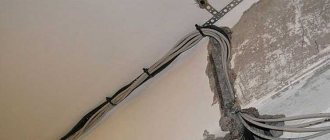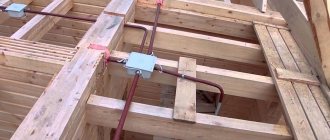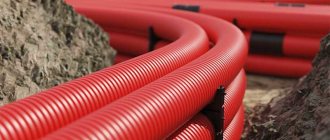Laying cables in pipes allows you to protect wiring from mechanical influences and organize power supply to the facility without installing poles. The mains are laid in the ground and entered into the building through the foundation. Pipelines are also used for installing wiring on the walls of houses, providing protection for the insulation from external climatic factors or mechanical damage.
Features of laying cables in pipes
Laying cables inside the pipeline is permitted by the rules of the Electrical Installation Code with a number of reservations. For example, regulations do not allow underground installation using steel lines. It is allowed to use solid or corrugated plastic, reinforced concrete or asbestos-cement (gradually being forced out of production due to the large mass and content of harmful substances in the material) pipes.
To reduce the effort when pulling wires, the lines are blown with compressed air with the addition of talc, which does not have a negative effect on the insulation.
When might this method be needed?
The technology for installing wiring in pipes located inside walls or ceilings is used in wooden houses. Metal sleeves protect the insulation and reduce the risk of fire in the event of a short circuit. It is possible to lay cables along facades or internal partitions (for example, for quickly upgrading existing wiring). When laying power wires underground, pipes are used to protect the insulation from external influences and prevent current leakage into the ground.
The technique is used at industrial facilities to organize new workplaces or install electrical cables in workshops. The wiring is laid in pipes on top of the trays, providing protection from external influences (for example, high temperature or chips). Sleeves can be stationary or mobile.
In industrial environments, it is permissible to install additional devices to protect or ensure mobility of wires.
In what case is a metal pipe needed?
No matter how durable modern plastic is, it is inferior to steel. Therefore, metal protective structures are used in cases where there is strong pressure on communications: a road passes over the line, there is a parking lot, a garage entrance, heavy or vibrating equipment is located, there is a danger of ground subsidence, landslides, and earthquakes. In some cases, metal is also used to protect against vandalism (for example, when lowering a cable from a support into the ground), if thieves are operating in the area where your dacha is located.
Metal is used if there is a danger of damage to communications during excavation work.
Laying power lines in steel pipes is used for wiring in hot shops, where there is a risk of sparks, in explosive and fire hazardous areas. In wooden buildings or when installing wires on wooden sheathing, only metal casings are allowed.
What cables are allowed to be used?
For installation in metal or plastic pipes, wires with a monolithic or stranded core are used:
- having elastic insulation made of plastic or polymers;
- not equipped with a protective layer (for lines made of dielectric with each core laid in a separate sleeve);
- equipped with several layers of insulation.
The list of cable products that can be laid in pipes is regulated by PUE standards. The standard allows the use of the body of steel mains as a zero line, provided that the hose is continuous. The rule applies only to three-phase power supply circuits. If it is intended to install cables in the ground without using pipes, then it is necessary to choose products with metal braiding (for example, AVBbShv, AAShp, AAShv or PvBShv). When selecting products, take into account the acidity of the soil, which affects the durability of the insulator.
Preference for using PVC and HDPE pipes
Electrical wiring in HDPE and PVC pipes has a number of advantages. The main advantages include:
- You will no longer need to use a welding machine to secure pipes.
- These products are lighter in weight.
- There is no corrosion on them.
- Their service life can be up to 50 years.
- If necessary, small diameter pipes can be bent.
- PVC pipes will look much better than metal ones when laying open wiring.
- Plastic pipes have excellent insulating properties.
- This product does not collect moisture.
Installation rules: methods and sequence of actions
There are several algorithms for laying electrical cables in pipes. The installation team marks the route, checking for the presence of underground communications, and then digs trenches, drills channels or lays cable drainage pipes. At the same time, windows are cut in the foundation to enter the power cable going to the distribution board. After the work is completed, a report is drawn up and submitted to the sales company. If necessary, test the power supply system using a portable mobile laboratory.
Trenchless installation method
If digging a trench is impossible (for example, under a road with a hard surface, which is not allowed to be cracked), then the cable trunking is laid using drilling technology. The machine drills a horizontal channel into the soil, expands the cavity and installs a plastic line. A cable is then pulled through the pipeline and connected to the substation and the building. Trenchless sections can be alternated with standard line installation in ditches dug by hand or with an excavator.
Construction of the trench
The laying ditch must have a depth of at least 700 mm and be located at a distance of 600 mm from the outer boundary of the foundation. The width of the trench is determined by the diameter of the pipe. The wires must be located inside the main line with a gap. The PUE rules stipulate the distance of the power supply line from gas and water mains. In this case, the cable should not pass under the foundation of the house. A sand cushion is poured into the bottom of the trench, and an earthen hill up to 150 mm high is built on top of the finished route and warning tape is installed.
Types of existing pipes
The main advantages of plastic materials are excellent corrosion resistance, extremely low weight and a high level of flexibility.
As mentioned above, the choice of tube material will depend on the room in which the cable is laid, its main features and conditions.
plastic pipes are fairly well-known and familiar elements to all of us - polyvinyl chlorides;
The main advantages of plastic materials are excellent corrosion resistance, extremely low weight, high level of flexibility and fairly low price.
If it’s too early to talk about price, then excellent corrosion resistance and the highest level of ductility in relation to cable routing are indicators that you need to pay special attention to
Also keep in mind that installation work with materials such as plastic pipes is quite simple and does not require special equipment or special skills.
Welding of elements can be done with conventional torches, especially since here, unlike plumbing, tightness is not so important.
steel;
In dry rooms, which are not characterized by high humidity and penetration from the outside, you can use a more affordable option for laying cables - steel pipes. As a rule, a thin-walled sample of material is used, the cross-section of which is approximately 15-20 mm. Steel pipes require the craftsman to have special equipment for welding.
You can also use threadless couplings to connect individual sections.
If steel pipes for laying cables go outside, it is better to paint them, because an unpainted pipe is susceptible to corrosion.
When installing a steel pipe, the following rules must be observed:
- cleaning and subsequent painting;
- bends no more than 90C;
- if several bends are expected in a section, then its length should not exceed 5 meters, and when bending, it is necessary to avoid crushing or breaking the pipe;
- complete tightness - in no case should open areas and cracks be allowed, since even air trapped inside the route can lead to oxidation of the contacts;
- in case of laying parallel routes, both pipes should be equidistant approximately 10 cm from each other.
Main safety requirements when organizing wiring in pipes
Rules for safe installation of cables in pipes in the ground:
- The depth of the trench cannot be less than 70 cm to protect people from electric shock when the insulator breaks down. At the bottom there should be a sand cushion with a thickness of 100 mm.
- The diameter of the pipe should be 2–3 times larger than the total cross-section of the wires laid inside.
- It is not allowed to lay the main under foundation slabs or at a distance of less than 60 cm from the building.
- If the cable is laid under a highway, its depth must be at least 1 m.
- The distance from the root system of trees cannot be less than 1 m. A similar rule applies to the position of the cable relative to water supply, gas supply and sewage disposal pipelines. The gap between the supply line and the heating hoses cannot be less than 2 m.
- If additional power lines are laid in the ground, then the distance between the cables should be 50 cm or more. Main lines are laid at a distance of 1 m from power transmission line supports and at least 5 m from ground loops buried in the ground.
Selecting pipes for installation in different conditions
Please note:
- Pipe diameter. The wider the socket, the thicker the wire can be laid in the pipe.
- Material density/wall thickness. Thin-walled pipes are used only in areas with low mechanical loads.
- Length of segments (required and production). If the design has a large number of straight sections longer than 3 meters, it will be more economical to use corrugation.
- Possibility of bending. A large number of turns will require the installer to solder/weld many connecting elements. Using corrugation will be easier to work with and cheaper.
- Product weight. If in an old house it is important not to overload the floors, it is better to choose plastic.
When choosing pipes, carefully read the markings
Advantages and disadvantages of the method
Advantages of installing a power supply system in pipelines:
- protection of electrical wiring from deformation or mechanical damage to insulation or metal conductors (for example, kinks);
- preventing the destruction of insulation during a fire in the room (in the event of a strong fire, the lines melt or heat up to a high temperature, which leads to the loss of the protective layer);
- protection of insulation from negative external factors (ultraviolet radiation or precipitation).
Disadvantages of technology:
- the cost of installation work increases;
- pipes located on the walls or facade deteriorate the design of the house;
- pulling cable through channels requires skill and additional equipment.
PVC pipes for electrical wiring
PVC pipe for electrical wiring is considered the best option. You can install the wiring in the PVC pipe yourself.
To install wiring using this method, you may need additional parts: tees, connectors, crosses and additional turns.
To attach them to a suspended ceiling, you can use a dowel tie. To attach the pipe in visible places, you must use a building level. The pipe will be attached to the wall using a clip.
Useful tips and general recommendations
When installing pipelines, it is necessary to ensure the tightness of the joints. The penetration of condensation, foreign liquids or dust accelerates the destruction of the insulation. When installing on a wall, the pipes are placed at an angle of 1–2° to the distribution boxes, ensuring moisture drainage. It is prohibited to connect steel lines by arc or gas welding, as sharp burrs will form at the joints.
The gap between the fasteners is selected according to the values indicated in the table.
| Line diameter, mm | Bracket installation pitch, m |
| from 18 to 26 | 2,5 |
| from 30 to 42 | 3,0 |
| from 45 to 90 | 4,0 |
| from 100 | no more than 6.0 |
Before laying the cable, it is recommended to check the tightness and tightness of the couplings. Since dirt gets into the lines during installation, it is recommended to blow out the hoses with dry compressed air. To protect against dust, temporary plastic covers are installed on the open ends. To provide free space between the insulation and the inner wall of the pipe and to simplify drawing, the wires are collected in bundles. To install cables, use soft steel wire with a diameter of 1 to 3 mm (depending on the cross-section and number of cores).
Installation features
During installation, it is important to follow the installation rules:
- It is advisable to minimize the number of pipe turns, since each angle complicates cable pulling.
- At network nodes - turns, branches and places where electrical appliances are connected - distribution and wiring boxes are installed. This will simplify cable pulling after pipeline assembly and maintenance of the electrical network during operation.
- To pull electrical cables, a steel string is used: first, it is pulled through the resulting cable channel, the string is connected to the cable and pulled out from the opposite side. Thus, cables are gradually laid throughout the pipeline and the sections of wires in boxes are connected, forming a single electrical network.
- Plastic bushings are fixed at the ends of the pipes, the purpose of which is to prevent chafing of the cable braid.
- It is better to connect pipes using threaded fittings - special connecting elements, and not by welding. This will simplify installation and further repairs.
- The pipeline is secured using clamps and brackets, the distance between which depends on the internal diameter of the pipes.
| Pipe internal diameter, mm | Distance between fastening elements no more than, m |
| 15-20 | 2,5 |
| 25-32 | 3 |
| 40-80 | 4 |
| 100 | 6 |
- Boxes - distribution and traction - are placed at such a distance to ensure ease of pulling cables and simplify their replacement in the future. This distance depends on the number of turns of the electrical cable.
We recommend that you read: Rules for installing stainless steel chimneys
| Number of corners | Distance between boxes no more, m |
| 1 | 50 |
| 2 | 40 |
| 3 | 20 |
- If it is necessary to rotate the cable more than 90 degrees, an additional cable duct will have to be installed at the turning point. Otherwise, when pulling the electric cable, it will be caught in the bend of the pipe and it will not be possible to pull it out.
Electrical safety and lightning protection in a wooden house
At its core, the electrical safety and lightning protection complex for a wooden house is not fundamentally different from this complex for houses made of other materials.
The grounding device is no different at all, but there are certain nuances in the construction of lightning protection. Here are some of them:
- The lightning rod must be mounted at a distance of at least 100 mm from the wall of the house. This is necessary to ensure fire safety. There is a separate type of fastener for attaching a lightning rod to the wall of a wooden house. Standard fasteners are not recommended.
- Lightning rods are mounted on separate remote brackets
- To avoid damage to the decorative finish of wooden houses, it is recommended to use free-standing masts for lightning protection of the house. This design will not only improve aesthetics, but also increase the level of fire safety.
Electrical wiring is one of the main communications in any home, regardless of its purpose.
It doesn’t matter whether you live in a private house permanently or visit it only in the summer, using it as a summer house, you will need electricity in any case. Is it possible to complete such a complex task as wiring a wooden house with your own hands, or is it still necessary to resort to the services of professionals?
Do-it-yourself electrical wiring in the house: stages of work
Both the construction of a wooden house and the supply of electricity to it are carried out according to a clear plan. The step-by-step diagram looks like this:
1. First, a general project is drawn up and an electricity supply diagram is drawn. 2. According to the drawn up project, the total power of all equipment is calculated (you need to take into account all the equipment that will be installed in the house). 3. Based on the calculated load, cables, meters and other installation elements are selected and purchased. 4. An input electrical switch is connected to the building. 5. The meter is being installed. 6. The distribution board is being installed. 7. Then comes one of the most painstaking stages of supplying electricity - laying cables in all rooms of the house. 8. After this, you can begin installing lighting fixtures, switches and sockets. 9. Then the grounding and residual current device must be installed. 10. When all work is completed, it is imperative to check and test all equipment. Only after this can it be considered correctly connected.











